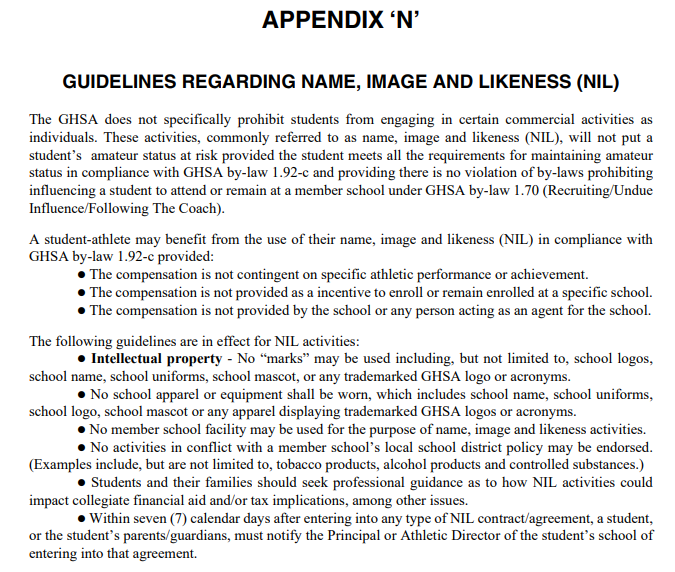GHSA executive committee approves new reclassification proposal, and NIL

By Michael A. Lough
The Sports Report
centralgasports@gmail.com
At first glance, the large number of people outside of a ballroom in the Wilson Convention Centre for a GHSA executive committee meeting indicated that perhaps reclassification might be a touchy topic.
Turns out most of those people were there as friends and family of the officials and referees for all sanctioned activities who were honored by the association.
Once that ceremony was over and those folks left, it was the normal crowd of a dozen or so people there for GHSA business.
The reclassification topic du jour this cycle is a plan to put the Class A, AAA, and AAA private schools in their normal regions for the regular season, and then put those private schools in Classes A, AA, and AAA into one group for the playoffs.
Discussion didn’t last very long. Mount Vernon athletic director Brad Dehem mounted the only real argument against voting for the plan because there were no details about the power rating system that will be used to determine the postseason teams.
He pointed out that Class 3A and 2A schools can schedule lower-classification opponents, but Class A can’t. He said that the previous power rating systems – which will be different than the new one – were all different for each class. But now, it will encompass three classifications with very different schedules – region opponents locked in – into one.
“Because now we have 1A, 2A, and 3A all together, I’m extremely opposed to this plan,” Dehem said. “I’m extremely opposed to power rankings, but I don’t think anybody here likes power rankings.
Consider supporting local, state, and national sports coverage with a donation to The Central Georgia Sports Report. 😎
〰️
Consider supporting local, state, and national sports coverage with a donation to The Central Georgia Sports Report. 😎 〰️
“I just think there are so many complicated factors in this.”
He pointed out that the ratings can’t measure things as they had in the past, and wanted clarity before unexpected problems might crop up..
President Jim Finch said the power ratings was something of a concession, with one early option just rating the new private school plan, but that more people wanted the power rating for both groups or neither.
“I don’t think anybody in here likes the power ratings,” he said. “But not as much as they (don’t) like the disparity in competitive balance between those types of schools. That’s how I’ve interpreted it.”
Another athletics director was against the plan because it meant that region champions might not make the playoffs if their rating wasn’t high enough.
“I don’t like that at all,” he said. “I’m not a very smart fellow, but I don’t think I can vote for something like that.”
Associate commissioner Don Corr said that it won’t be the same formula as previously used in conjunction with MaxPreps.
Nevertheless, the plan passed 53-18, with four absentions.
The next step in reclassification comes in several weeks when that committee gets the enrollment figures filed by schools with the state.
The GHSA is going back to six classifications, with Class A still split among divisions. Class 6A will be the biggest 14 percent, with Class A the smallest 26 percent, and the middle classifications divided equally.
There will be some changes in Central Georgia when those numbers come in and the reclassification committee gets back to work. Under the 2021 enrollment figures that set up the 2022-23 and 2023-24 regions,
A quick glance at the 2021 enrollment numbers and doing the new math indicates that Houston County – currently among the top five largest Class 6A schools - would be in 6A, with Northside and Warner Robins in 5A.
The last reclassification period, Perry was in 5A, but its appeal to be in 4A passed 17-0-1.
The final season of six classes was in 2015, which also had Class A as one class. No Central Georgia teams were in 6A, and nine-team Region 2-5A had Houston County, Northside, Warner Robins, and Jones County, and Augusta-area schools.
The seven-team Region 2-4A had Baldwin, Howard, Mary Persons, Perry, Upson-Lee, Veterans, and West Laurens.
Back then, though, Class A had many more private schools, all competing in the regular season and playoffs with public schools, with a power rating system.
Once the reclassification committee places everybody, the appeals process begins, which then takes up meetings in November and December.
The committee also approved, as expected, a name-image-likeness proposal. Athletes must report any NIL agreements to school administrators for accountability, and violations can lead to being ruled ineligible.
“Keep in mind that this does not allow pay for play,” executive director Robin Hines said. “You can not be paid for athletic performance. What we’re talking about here is that every individual, including you and I, we own our own name, image and likeness. What we do not own is the intellectual property of the association or the school itself.”
He noted that the NIL plan isn’t just for athletes, but he reminded about undue influence rules and recruitment. He said about 31 state associations are allowing some form of NIL.
Hines also pointed out there are very few, if any, similarities to the college NIL plan and that of most high school associations.
“This is a way for us to put guard rails on our situation,” he said.
Hines reported that the association was in better financial health, thanks in part to an improved stock market and greater investment wealth after a few years of declines.
Revenues grew by 7.9 percent and expenses by .9 percent. Postseason tournament revenue increased by $694,000.
“Payouts to schools was $3.2 million, which was an increase of $739,000,” Hines said. “We’re real proud of that, that money going back to our schools.
“This is the fourth year in a row where there have been no dues or catastrophic insurance payment (from schools).”

